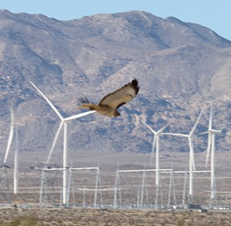
UPDATE: February 28, 2013 -- Judge Curiel has denied the plaintiff's motion for summary judgment. Plaintiff's have not yet announced whether they will file an appeal. View decision here.
“The codes are quite clear …You can’t take a Swainson’s hawk. Not even one…There is also no take for Peregrine falcons and owls. If turbine curtailment is good enough for golden eagles, it should be good enough for these species, too.” ----Laurens Silver, attorney for plaintiffs
“It is not the BLM’s role to enforce state law…All through downtown there are glass buildings that could cause a take.” – Marissa Piropato, attorney for the U.S. Bureau of Land Management
By Miriam Raftery
Maris Brancheau also contributed to this report
February 27, 2013 (San Diego) – Is the federal government turning a blind eye to violations of state laws intended to protect raptors (birds of prey) and other wildlife at the Ocotillo Express Wind Facility? That’s the contention of a lawsuit filed by the Desert Protective Council, an environmental group, and others against the U.S. Department of the Interior, Bureau of Land Management (BLM), Secretary of the Interior Ken Salazar, Pattern Energy and others.
Other plaintiffs in the case include the Laborers’ International Union of North America Local Union No 1184, individuals Hector Casillas and John Norton, as well as Ocotillo residents Jim Pelley and Parke Ewing, two freelance photographers whose works published in East County Magazine have documented close calls with raptors and whirling blades at the site.
The lawsuit puts forth multiple arguments faulting the federal government for failing to adequately protect raptors such as eagles, hawks and owls at the site. Plaintiffs have asked the court to vacate project approval and suspend operations pending compliance with the National Enviornmental Policy Act (NEPA) and the Federal Lands Policy Management Act (FLPMA).
Judge Curiel questioned attorneys for both sides, focusing mainly on the process of issuing “take” permits which allow a designated number of birds from a particular species to be killed accidentally without penalty.
Federal law allows take permits to be issued even for threatened species, such as golden eagles. However state law is more stringent, flatly prohibiting any take of raptors. There are additional protections for threatened species such as the Swainson’s hawk, which is slated to begin its annual migration through the project site in March.
Plaintiffs’ attorneys Michael Lozeau and Laurens Silver argued that Pattern’s own draft Avian Protection Plan had indicated that turbines could be curtailed, or shut down, to protect all biological species. But the final Plan calls for shut down only when golden eagles are detected at the wind facility – not any other species, despite the fact that California state law offers identical protections to several other raptors found at the site including Swainson's hawks.
“ If turbine curtailment is good enough for golden eagles, it should be good enough for these species, too,” Silver told Judge Curiel. He noted that the project site has had more visits by Swainston hawks recorded than other raptors. Moreover, the federal government’s plan allows “113 raptor takes before they even have to tell the feds.”
If turbine curtailment is good enough for golden eagles, it should be good enough for these species, too,” Silver told Judge Curiel. He noted that the project site has had more visits by Swainston hawks recorded than other raptors. Moreover, the federal government’s plan allows “113 raptor takes before they even have to tell the feds.”
BLM’s lawyer stood firm. “Turbine curtailment is only being deployed for eagles” If there is a Swainson’s hawk taken, this will trigger a consultation of the Techincal Advisory Committee, she added.
Silver contended that “Eighty percent of the site as contemplated is a death trap for raptors likely to fly into the turbines.”
Lozeau added, “Why would eagles get curtailment, when Swainson’s hawsk are state threatened and you’re not supposed to ever kill them?”
The California Department of Fish and Game submitted comments on a draft Environmental Impact Statement for the project, issuing a stream bed permit, but remained silent on raptor issues. Three separate codes protect the raptors, however, and no takes are allowed for the species listed.
“It is not the BLM’s role to enforce state laws,” Marissa Piropato, attorney for the BLM, fired back. “If there is a problem, the trustee needs to make a comment, and the Department of Fish and Game hasn’t.” She then tried to argue that no tall glass building could be built if developers had to worry about running afoul of the state’s take provision. She also contended that if too many raptors are killed, the BLM has “tools in its tool box” to deal with the issue.
Plaintiffs' attorney Silver observed, “The government is arguing they have to put in the conditions only if the state asks them? That’s not rational. The law is already on the books.”
Judge Curiel asked if incidental take exceptions that absolve motorists who accidentally strike a raptor might be applicable due to lack of willfulness.
Plaintiffs’ counsel indicated that courts have held willfulness is not required to find that an illegal take of wildlife has occurred, such as when fish have been inadvertently ground up in water pumps – a scenario similar to raptors sliced apart by wind turbine blades.
“The take prohibition is clear on its face,” said Louzeau, adding that the state should not have to take extra steps to make the federal government comply. Plaintiffs’ counsel further argued that the Federal Lands Policy Management Act (FLPMA) requires specific terms and conditions to comply with state standards. If Pattern wanted an exception, it should have applied for take permits, but did not. With migration of Swainston hawks set to begin in March, the need for protection is imminent, plaintiff’s contend.
Plaintiffs further argued that the project’s Right of Way language is too vague, citing a 9th Circuit case that found requiring “minimum adverse impacts” or “compliance with all laws” was too vague.
Pattern Energy’s attorney argued that the State Endangered Species Act would apply only to Swainston hawks and that the company’s plan for eagles includes mitigation.
That “mitigation” includes use of controversial Avian radar system by Merlin; no videos showing the system actually working to shut down when birds approach have ever been provided to ECM despite requests to the manufacturer. Moreover, a representative from another wind company, Iberdrola Renewables, has told ECM that there is no evidence that avian radar works to detect individual large birds such as eagles. An eagle was recently killed at the North Sky River project equipped with the Merlin Avian radar system.
Throughout the proceding, defense lawyers contended that the BLM t has no responsibility to assure that the project developer, Pattern, comply with the state’s strict zero-tolerance laws for killing threatened or endangered species.
“If there is zero tolerance, how could any turbines pass muster?” Judge Curiel asked toward the close of the hearing.
Lozeau pointed out that Pattern itself had indicated in its own draft Environmental Impact Statement that it has the capability to shut down turbines for “all biological species” yet the Final EIR oddly restricts turbine shut-off only to eagles, ignoring concerns for other species.
“Our position is that curtailment could minimize take. We’re not asking anybody to do the impossible,” Lozeau said in closing. “We just think they should do the mitigation hey suggested in their own draft Avian Bat Protection Plan to curtail to save all biological resources. If it’s good enough for eagles, it should be good enough for other species.”
The BLM attorney insisted that it should retain authority to address the problem through possible future mitigation and be granted “wide discretion” in the matter.
Judge Curiel concluded the hour-and-a half proceeding, indicated that he had “heard enough” to make a decision. He said he expects to issue a ruling with a week on both the Desert Protective Council case at hand, as well as on a case filed by the Quechan Indian tribe alleging violation of cultural resource protection laws at the Ocotillo Wind Express Facility.
Legal documents:








Comments
CASE OVER WILDLIFE THREATS POSED BY OCOTILLO WIND PROJECT
I believe everyone has right to live peacefully. Tribals are tellig that they are facing problems for wind project. I dont know how to solv this problem. But I believe cultural of tribals should not be violated and this is also right we need new projects.
Ocotillo windscam
I can't find a word strong enough to describe the downright greed and lack of respect for communities and the environment these State agencies the BLM and the energy oligopoly is displaying in the push for their "too big to fail" energy sprawl plans for our public lands. Make no mistake about it, the energy oligopoly is fully aware of the risk to their business model from rapid technological advances and cost reductions in energy efficiency, response demand and roof top solar and CCAs. The race is on, to hell with the people and the environment, they must get their infrastructure built so they can twist the arm of the CPUC, cry "it's too big to fail", lock the rate payers and tax payers into their guaranteed profits scams. I refuse to give them any more of my money, I am dropping off the grid, I hope you do too, can't afford to do the entire house, just do a few rooms with a solar kit, they are affordable, expandable, and easy to put together, COSTCO has excelent kits, as well as Northern Arizona Wind and Sun.
A disgusting comment made for a truly disgusting industry
“It is not the BLM’s role to enforce state law…All through downtown there are glass buildings that could cause a take.” – Marissa Piropato, attorney for the U.S. Bureau of Land Management “It is not the BLM’s role to enforce state law…All through downtown there are glass buildings that could cause a take.” – Marissa Piropato, attorney for the U.S. Bureau of Land Management
What a truly disgusting comment made by Marissa Piropato. When was the last time an eagle, a burrowing owl, or a peregrine falcon, flew into a building anywhere in the world. Where are the piles of bodies that have fallen to the ground? Yet untold thousands of these species have hit the ground around turbines behind the guarded perimeters of your wind projects.
The wild places left in the world are like an oasis in the desert for these species. But this industry thinks they have the right to take this away from these species with their deadly turbines and turn these special habitats into massive avian death traps with a 3 thousand mile footprint. For the perpetrators, there is no good answer for this carnage. That is why they must divert the impact of their slaughter to such things as glass buildings, cats, coal, cars, climate change, acid rain. I have seen this industry say about anything to fool the ignorant and then fortify it with a bogus study.
What we really need is a study correlating dead raptors with the profits generated by wind industry financiers and executives.
For those of us that do not live indoors and appreciate the many species that make up the real world, it was truly disgusting comment made on behalf of a truly disgusting industry.
Looks like other parts of
Looks like other parts of the country are beginning to regain their sanity about these ghastly "wind farms." Dare we hope it could happen here?
http://www.foxnews.com/politics/2013/02/26/cape-cod-community-considers-taking-down-wind-turbines-after-illness-noise/